
Fascinating
In our solar system, there is only one star, the Sun, and it is incredibly massive. With a diameter estimated to be 1,391,980 kilometers, it surpasses the size of the planet Jupiter by more than 10 times and is 109 times larger than our own planet Earth. The largest stars in the universe: the top 10
However, when compared to other stars in the Milky Way galaxy or the observable universe, the Sun appears relatively small.
Before we delve into the topic, there are a few key points to keep in mind.
- Massive stars are measured in solar units, where 1 R☉ is equivalent to 695,700 kilometers (the actual radius of the Sun).
- Stellar radii or diameters are typically not precise as they are estimated using the Stefan-Boltzmann law, allowing for a significant margin of error.
- The dimensions of a star are primarily influenced by key factors like its luminosity and temperature.
- The expanded atmospheres of supergiants can undergo considerable size fluctuations over time, making it challenging to accurately calculate their stellar luminosity.
10 CW Leonis or IRC +10216: A Unique Celestial Phenomenon
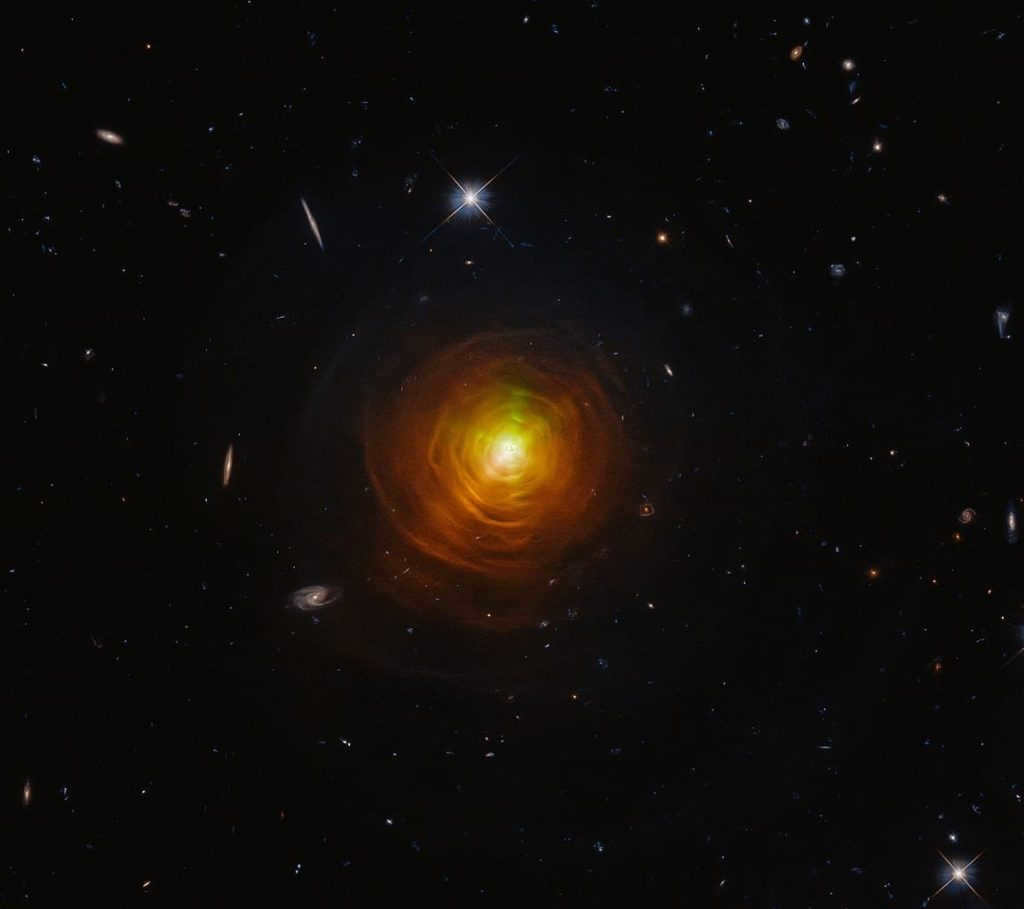
- Distance: 310 light years away
- Solar radius: 390 – 500 times the radius of the Sun
Situated in the Leo constellation, CW Leonis is likely the nearest carbon star (a luminous red giant with a higher carbon-to-oxygen ratio in its atmosphere) to our solar system and Earth. Based on the existing information, scientists are confident that the star will transform into a white dwarf at some point in the remote future. Additionally, it is believed that the star may be accompanied by a potential binary star in close proximity.
9 Betelgeuse.
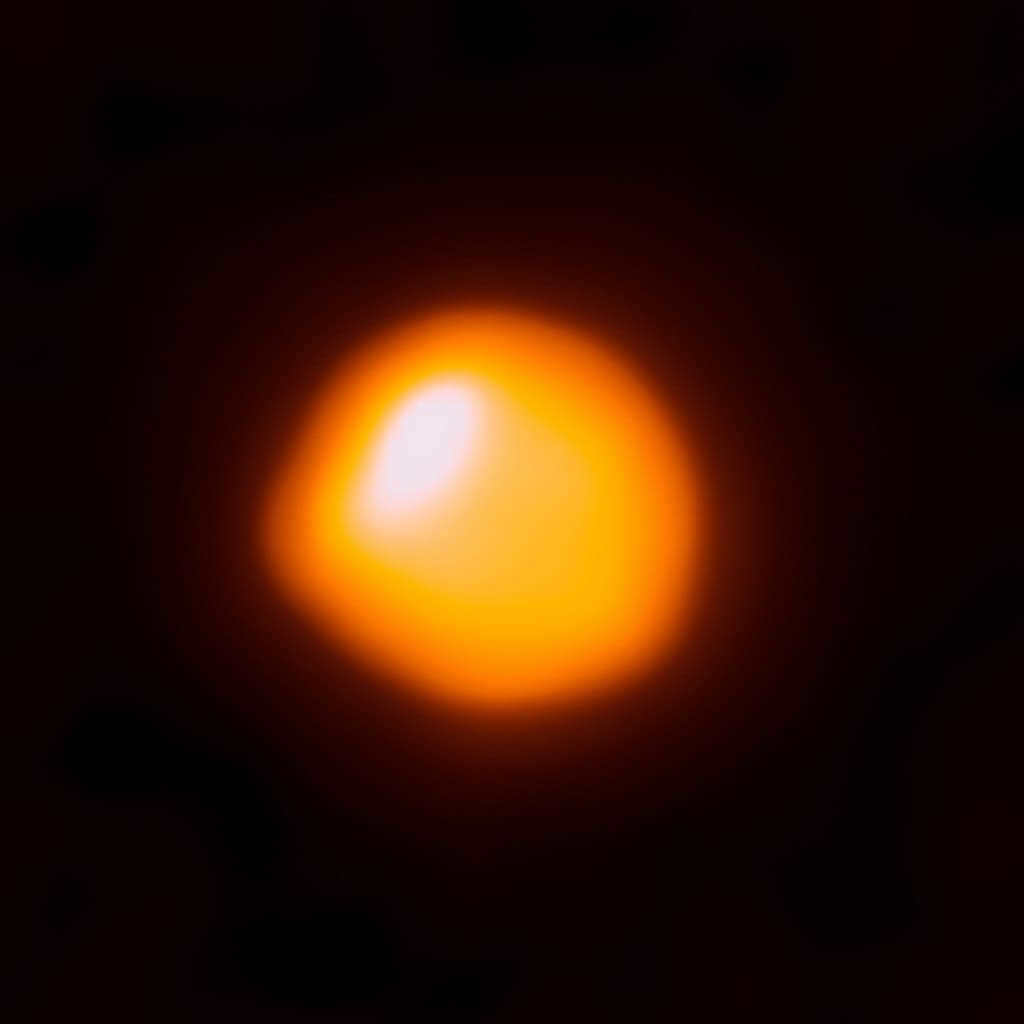
- Approximately 724 light-years away (subject to debate)
- Size in comparison to the Sun: 887-955 times larger
Betelgeuse, also known as Alpha Orionis, is one of the most massive stars visible in the night sky and the second brightest star in the constellation Orion. It is famous for its distinct reddish hue and irregular shape.
If this colossal red supergiant were located at the center of our solar system, it would engulf the orbits of all the inner planets, including Earth, Mars, and possibly Jupiter. It holds the distinction of being the first star, apart from the Sun, to have its angular size successfully measured.
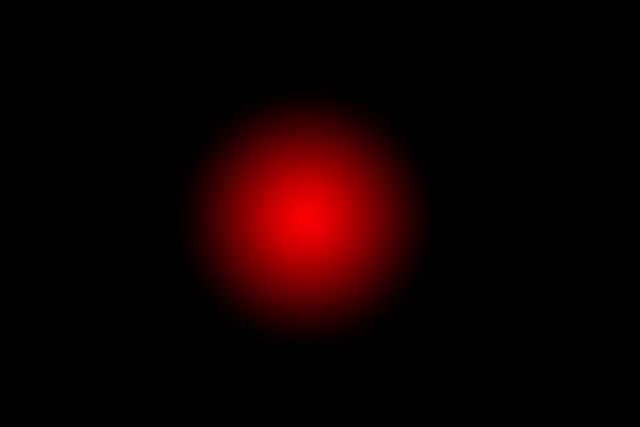
- Distance: 7,800 light years
- Solar radius: 1.009 R☉
KW Sagittarius, a red supergiant, can be found in the Sagittarius constellation, near the galactic nucleus, at a distance of approximately 7,800 light years from our solar system. If KW Sagittarius were positioned at the heart of our solar system instead of the Sun, it would fully encompass the orbit of Mars and potentially even the asteroid belt.
7 NML Swan.
can be paraphrased as:
The majestic 7 NML Swan.
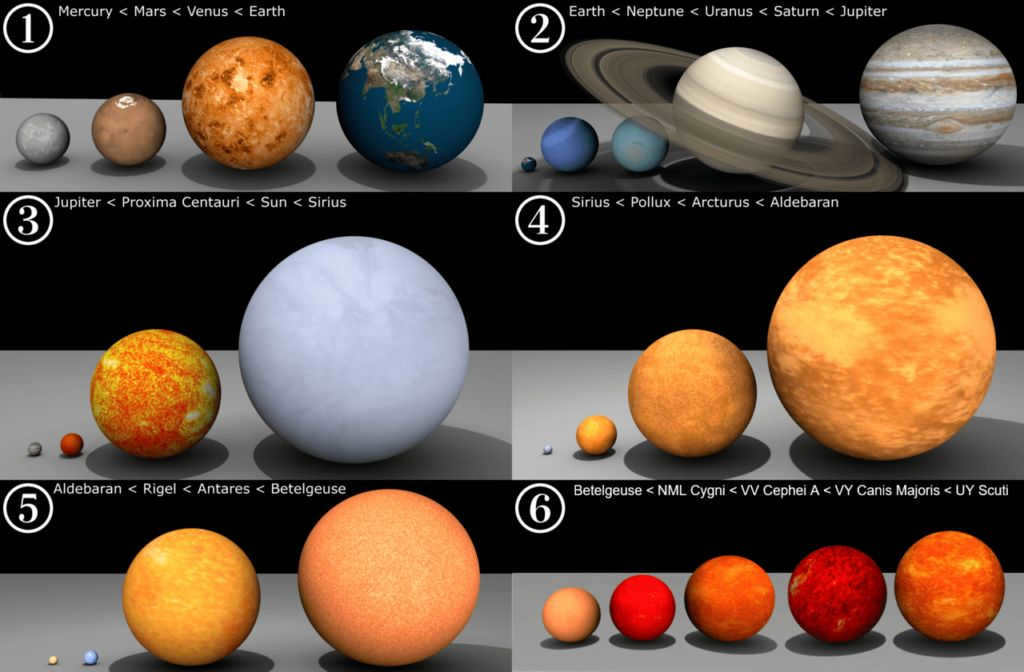
- Distance: 5,300 light years
- Solar radius: 1.183 R☉
The Swan’s NML star was initially observed by three astronomers, Neugebauer, Martz, and Leighton, in the year 1965. The astronomers took note of an incredibly bright red star. The size of the Swan star is approximately 20 billion times larger than the size of our own Sun. If this star were to be placed at the center of our solar system, it would completely engulf the orbit of Jupiter and potentially even more celestial bodies.
6 SMC 018136
can be paraphrased in English as
6 SMC 018136
.
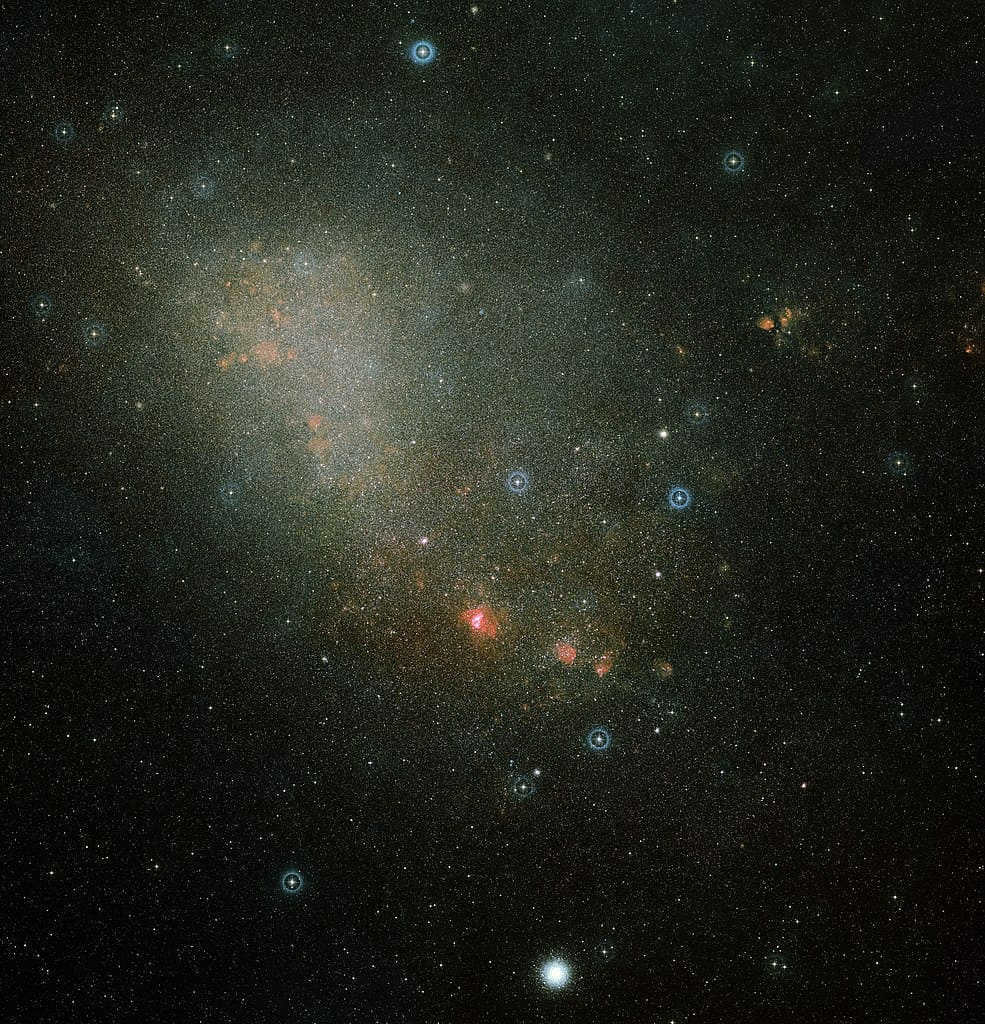
- Solar radius: 1,310 R☉
The Small Magellanic Cloud (SMC) contains an extragalactic supergiant star known as SMC 018136. This M-type star has a radius that is over 1,300 times larger than the Sun and is located in the Small Magellanic Cloud. With an effective temperature of 3,575 K and a bolometric power exceeding 200,000 times, SMC 018136 is considered one of the most distant massive stars ever discovered.
5 VV Cepheus A.
The star system known as 5 VV Cepheus A is a fascinating celestial object. It is located in the Cepheus constellation and has been the subject of much scientific research. Scientists have observed that this star system consists of multiple stars, making it a binary star system. The primary star in this system is a massive blue supergiant, while the secondary star is a smaller companion. The primary star is known to be highly unstable, undergoing periodic eruptions and releasing large amounts of energy. This makes 5 VV Cepheus A an interesting object for astronomers to study.
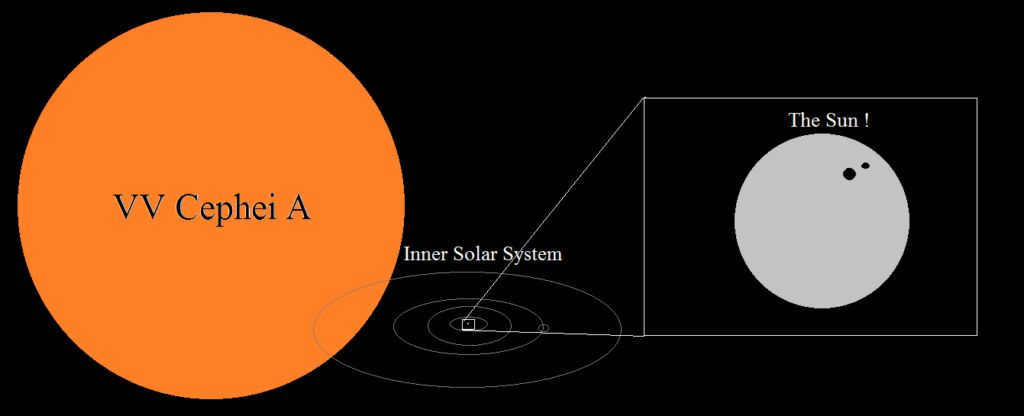
- Distance: 4,900 light-years
- Solar radius: 1,400 R☉
VV Cepheus A is the dominant component of the binary star system VV Cepheus, which is situated at a distance of around 5,000 light-years in the Cepheus constellation. This red hypergiant star is believed to possess a radius ranging from 1,050 to 1,100 times that of the Sun.
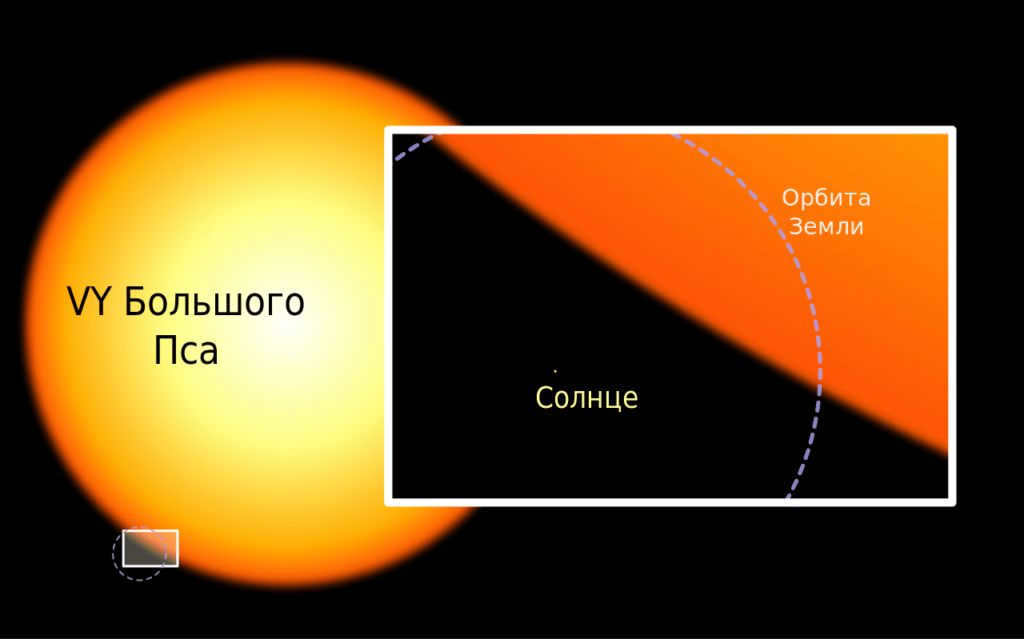
- Distance: 3,816 light-years
- Solar radius: 1,420 R☉
VY of the Big Dog previously held the record for being the largest star in the Milky Way galaxy until a significantly larger star was discovered. It is located in the southern constellation Canis Majoris and cannot be seen with the naked eye due to its dimness. It is classified as an M-type hypergiant and is one of the brightest stars of its kind. The estimated mass of VY Big Dog is approximately 17 times that of the Sun.
There has been much debate over the star’s actual solar radius and luminosity throughout the years. Some scientists argue that the star’s immense solar radius surpasses the expectations of current stellar theory, making it a highly vulnerable entity. Many believe that the star is not a hypergiant, but rather an ordinary supergiant with a reduced radius of 600 R☉.
3 Westerland 1-26.
Rephrase the text, making it unique, using the English language and preserving the HTML markup:
3 Westerland 1-26.
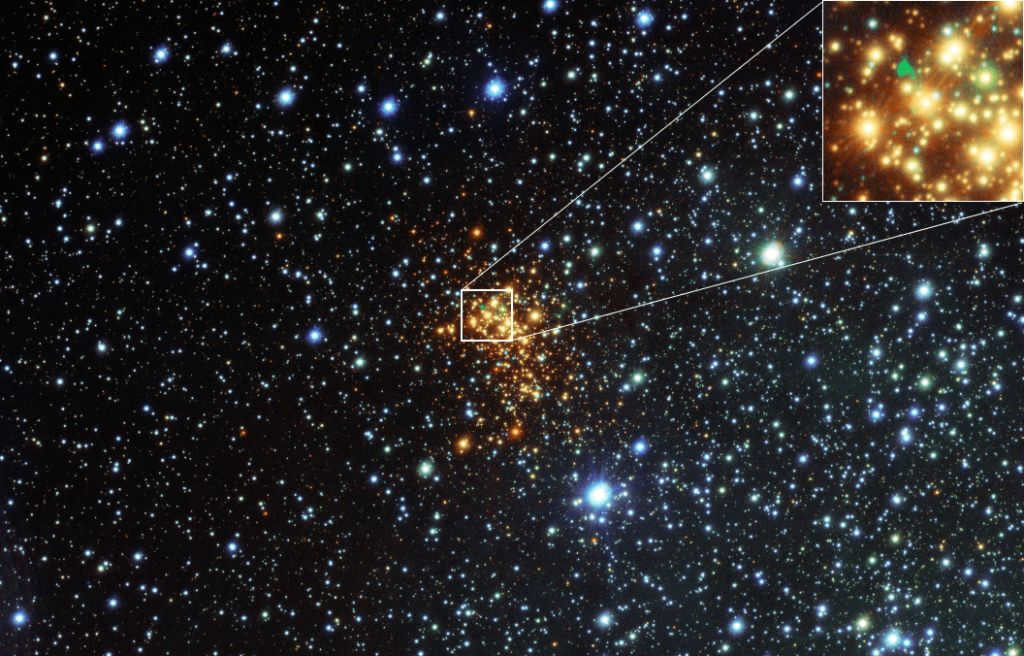
- Distance: 11,500 light-years
- Solar radius: 1.530 to 1.580 R☉
Located on the periphery of the Westerlund-1 superstar cluster, Westerlund 1-26 is the second largest star in the Milky Way galaxy. The exact classification of this star is still unknown, but it is estimated to be 3.5 to 4 billion times bigger than the Sun.
Situated at a distance of 11,500 light-years, Westerlund 1-26 is challenging to observe in the visible spectrum due to the significant amount of interstellar dust present in its vicinity.
2 WOH G64.
can be rephrased as
Two WOH G64.
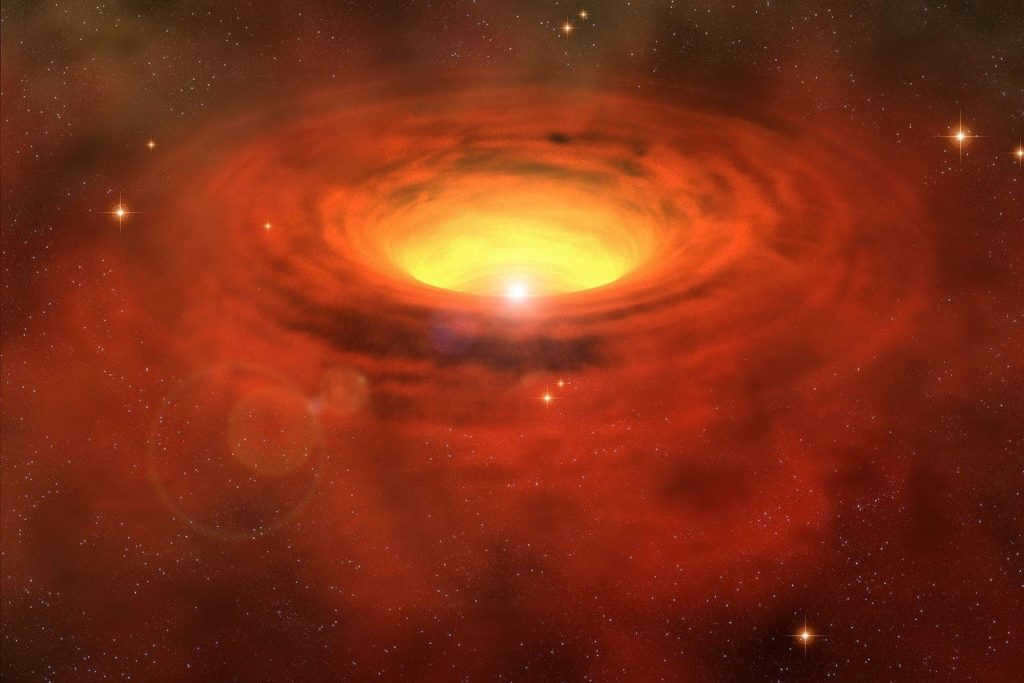
- Distance: 163,000 light years
- Solar radius: 1 540 R☉
At a distance of 163,000 light-years from Earth, WOH G64 holds the title of being the largest star in the Large Magellanic Cloud, a satellite galaxy of the Milky Way. This extragalactic star is an astonishing 5 billion times larger than our Sun. It was initially identified by astronomers Westerlund, Olander, and Hedin in the 1970s.
Shield 1 UY.
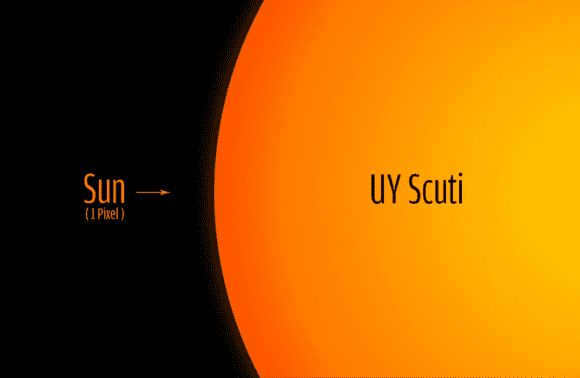
- Distance: 9,500 light years
- Solar radius: 1.708 R☉
Discovered in the 19th century by a team of German astronomers at the Bonn Observatory, Germany, UY Shields was initially known as BD -12 5055. It is located in the Scutum constellation and stands as the largest star currently known. With an estimated radius of 1,708 solar radii, UY Shields surpasses the Sun in size by 5 billion times.
The size of our sun is immense: it has the capacity to contain over a million planets within it. However, when compared to other stars in the universe, it can easily be engulfed by most of them. The question remains: which star holds the title for being the largest?
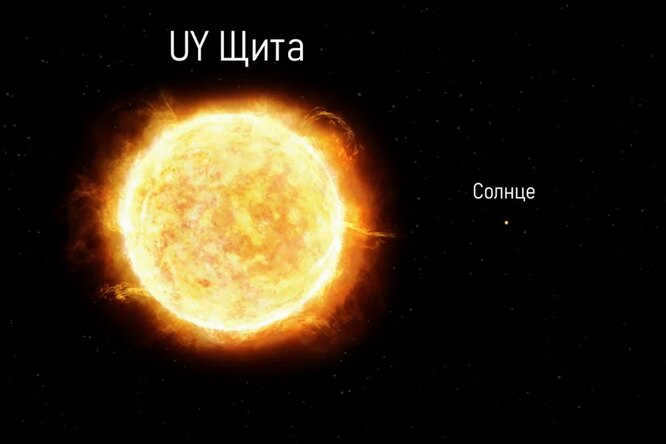
The Bonn Observatory in Germany was the first to document and name Shield’s UY, which they called BD -12 5055, in 1860. Recent findings published in the journal Astronomy reveal that during subsequent observations, astronomers noticed that the star’s brightness fluctuates over a period of 740 days, leading to its classification as a variable star.
The Universe’s Most Massive Star
Situated approximately 9,500 light-years away from Earth, the largest star in the Universe can be found near the heart of the Milky Way. Nestled within the constellation Shields, UY Shields is classified as a hypergiant – a rare type of star that emits an exceptionally brilliant light. Hypergiants, exceeding the sizes of both supergiants and giants, undergo significant mass loss due to the influence of rapidly moving stellar winds. However, it is important to note that determining the precise dimensions of stars can be challenging. Astronomer Gillian Scudder from the University of Sussex explained, “One of the challenges with studying stars is that their boundaries appear blurred when observed. Unlike solid objects, stars lack a distinct surface that separates the gas from the vacuum surrounding them. Consequently, establishing clear boundaries for stars proves to be a complex task.”
Instead of looking at a star’s photosphere to determine its size, astronomers observe the surface where the star becomes transparent to light, known as the photosphere. This is where quanta of light, known as photons, can escape from the star. In the field of astrophysics, the photosphere is considered to be the surface of the star.
If Shield’s UY were to replace the Sun at the center of the solar system, its photosphere would extend just beyond the orbit of Jupiter. The gas nebula emitted by the star would stretch far beyond the orbit of Pluto, covering a distance that is 400 times greater than the distance between Earth and the Sun.
Comparison is the key to understanding. This is why astronomers have introduced units of measurement, such as the mass of the Sun (M⊙) and the luminosity of the Sun (L⊙), into their professional activities. But what else can we compare it to?
As mentioned earlier, UY Shield is not even “the Sun at maximums”. Our Sun is just a yellow dwarf, of which there are many in the cosmos. UY Shield, on the other hand, is a red supergiant. It has a mass of 7-10 M⊙ and its luminosity is 120,000 times greater than that of the Sun. Luminosity is a measure of the total energy emitted by a star per unit time. Therefore, UY Shield claims to be not only the largest star in the world, but also the largest and brightest star in the Universe.
The physical characteristics of UY Shield
- Galactic longitude – 19.1436°;
- Galactic latitude – 00.4722°;
- Distance – 9500 sv years from the Sun;
- Mass – 7-10 M⊙;
- Radius – 1708 ± 192 R⊙;
- Temperature – 3365 ± 134 K;
- Luminosity – 340,000 L⊙.
An intriguing fact about the largest star ever discovered: it undergoes a process of gradual dissipation each passing year. UY Shield diminishes its mass by 5.8⋅10-5 M⊙ within a single year. This phenomenon further validates the metaphor that the most brilliant stars tend to burn out the quickest.
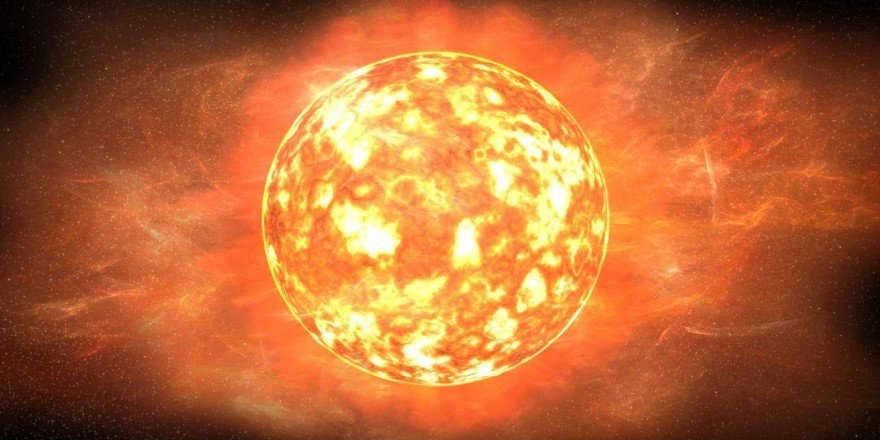
Introducing Shield UY, the most enormous star in the entire Universe! This celestial giant is of such immense proportions that it has the ability to engulf our very own Sun. Its vast size is truly awe-inspiring, as it reigns supreme within the Milky Way galaxy. Prepare to be amazed by the sheer magnificence of this hypergiant star.
In a critical state
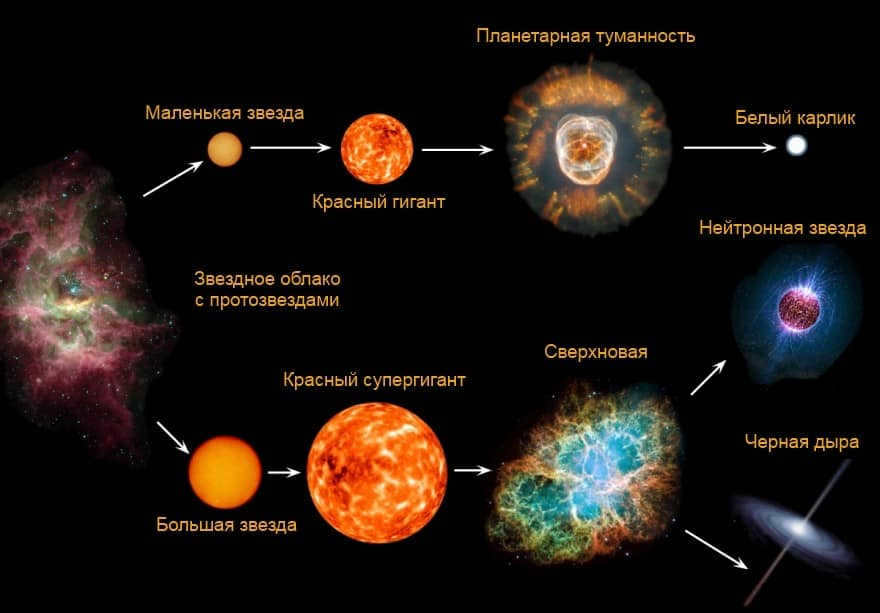
Hypergiants are stars that possess incredibly immense masses and sizes. Typically, they attain a mass of 100 to 120 solar masses. Theoretical calculations indicate a limit of 150 solar masses, yet scientists have discovered stellar entities that reach between 200 and 250 solar masses!
This limit is considered to be critical as the object teeters on the threshold between stellar evolution and transforming into a black hole. The surface temperature spans from 3200 K to 35000 K. However, the life of a hypergiant should not be begrudged.
Hypergiants typically have a lifespan of merely a few million years, with some even lasting only hundreds of thousands of years, before ultimately undergoing a collapse into a black hole. These celestial entities are incredibly scarce, with an estimated count of around 10 within our own Milky Way galaxy.
The Universe’s most massive star
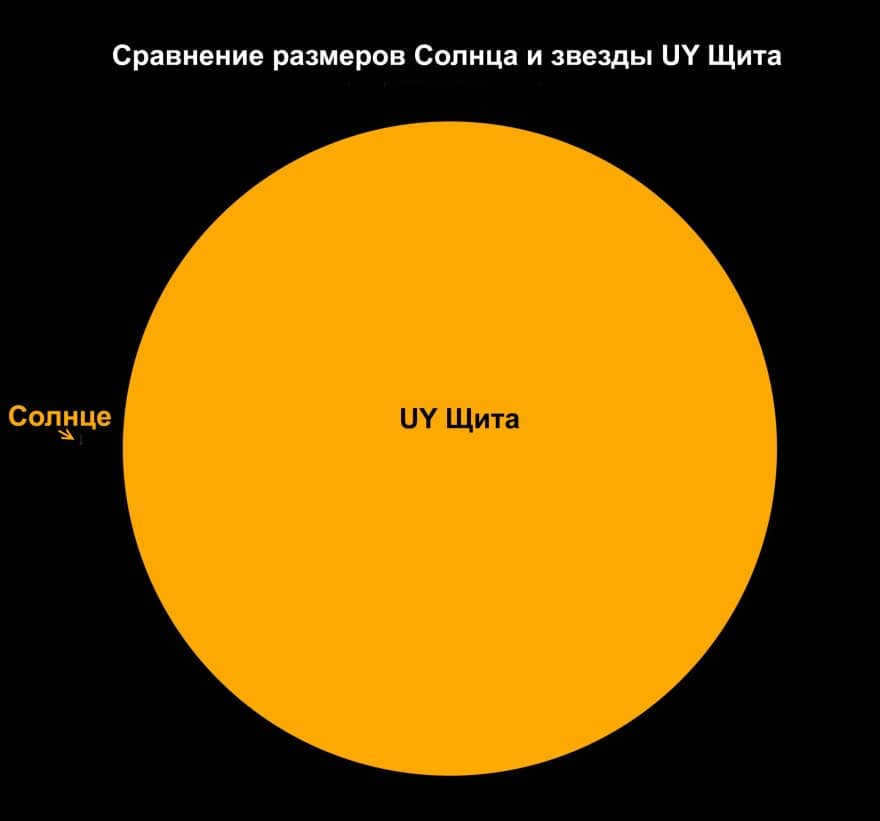
A comparison is being made between the size of the Sun and UY Shields, which is the largest star in the Universe. UY Shields is located in the constellation of the same name and is approximately 9,500 light years away from our sun. In addition to its impressive size, UY Shields is also known for its brightness, second only to Epsilon of Ascendant B.
To grasp the enormity of the situation, one must compare it to the typical values of our own solar system. The star, at its peak pulsation, has a radius that can encompass 1900 times the size of the Sun (growing to 2,100 times) and a volume that is 5 billion times 5 billion times larger! If it were possible to place the UY Shield at the center of our Solar System, its photosphere would extend to the orbital path of Jupiter and could even reach Saturn! This means that the inner planets and any form of terrestrial life would have to bid farewell.
UY Shield is 120,000 times brighter than the Sun, but it is believed that this figure is actually much higher due to the obstruction of the view in the visible part caused by dust and gas clusters. Additionally, UY Shield is rapidly losing mass, making it the fastest burning star known to us.
Interesting facts about UY Shields
- If we envision our planet Earth as being the size of a grain of buckwheat and the Sun as being the size of a watermelon, UY Shield would be as tall as the Ostankino Tower in terms of its diameter.
- If a spacecraft were to travel at the speed of light, it would take approximately 8 hours to reach UY Shield.
- If the International Space Station (ISS) were to orbit around UY Shield at its normal speed (as it orbits around the Earth), it would take 5 years for the station to complete its journey. Yes, 5 years. It’s worth noting that the orbital station moves 20 times faster than a bullet.
- The rate at which UY Shield expands and contracts is comparable to the speed of a spacecraft.
- UY Shield loses approximately 19 times the mass of the Earth every year.
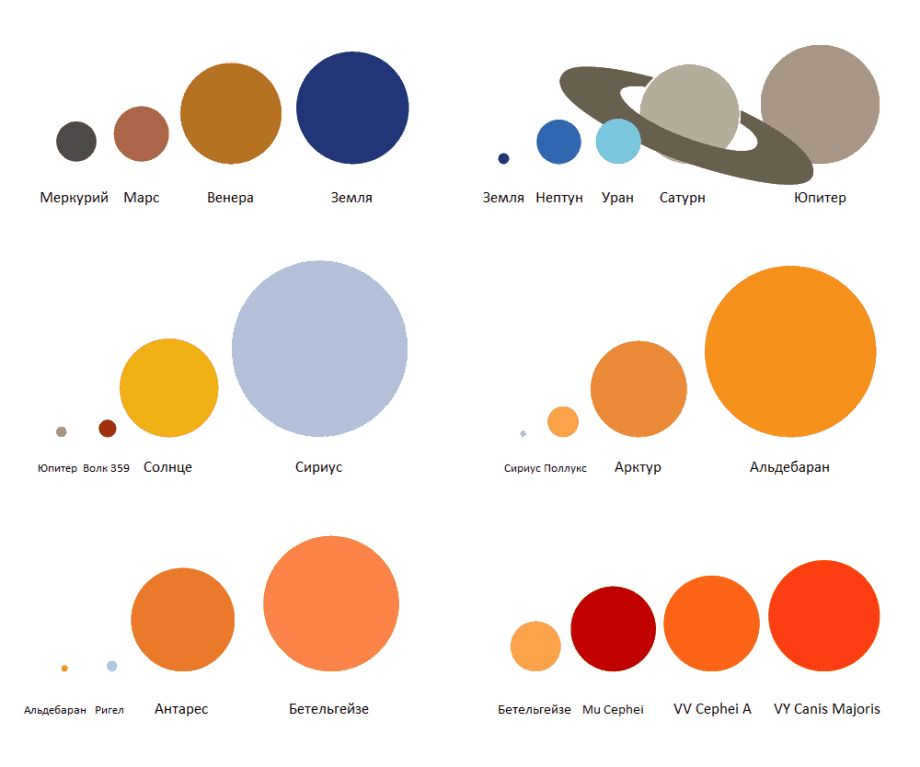
Comparison of sizes of various objects within the Solar System and stars within the Universe
It is crucial to note that there is a small caveat. UY Shield is currently recognized as the largest star within the Milky Way and the entire Universe. However, scientists have not yet been able to accurately measure the distances to such massive stars, which means that the parameters are subject to variation. Additionally, the instability and blurry structure further complicate the determination of the precise boundaries.
The radius of UY Shield can extend up to 2100 times that of the Sun. However, there are three other contenders:
- VV Cepheus A – 1900 times the size of the Sun.
- MY Cepheus – 1750 times the size of the Sun.
- VY Big Dog – 1708 times the size of the Sun.
Comparison of the sizes of VY Big Dog and the Sun
P.S.
It’s important to remember that not all stars are visible to us, so there could be a genuine celestial behemoth lurking elsewhere that far surpasses the mentioned contenders.
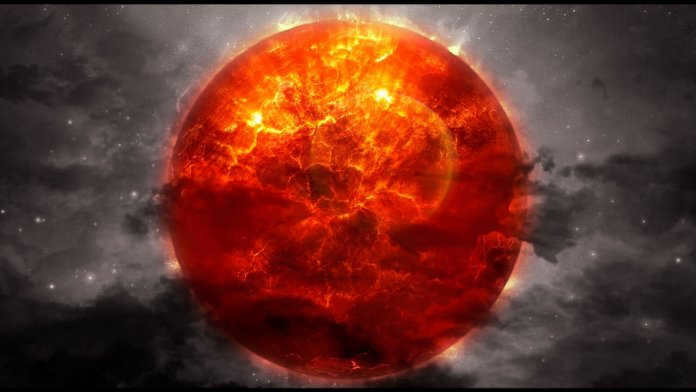
Stars are massive spheres of burning plasma. However, apart from our Sun, they appear as minuscule points of light in the nighttime sky. Having said that, our Sun is not the tiniest or largest star out there. There are numerous stars that are much more massive and bigger than the Sun. Some of these stars have undergone changes since their formation, while others are expanding as they progress through their lifecycle.
In order to determine which star is the largest in the Universe, we have categorized the stars based on their size. The equatorial radius of the Sun, which measures 696,392 kilometers, has been used as the standard unit for stellar radius.
10. V766 Centauri
10th star in the Centauri constellation
Centauri’s 10th star, V766
The celestial body known as V766 in the Centauri constellation
The 10th star in the Centauri constellation, V766
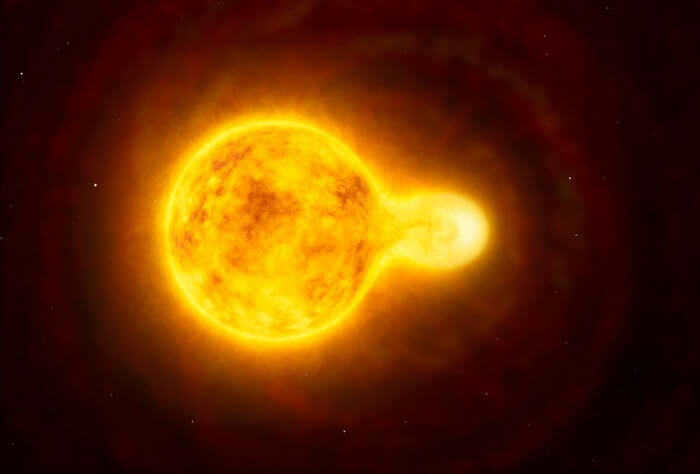
V766 Centauri, also referred to as HR 5171 A, is a double star and a yellow hypergiant. The celestial object HR 5171 B revolves around V766 Centauri in a period of 1300 Earth days.
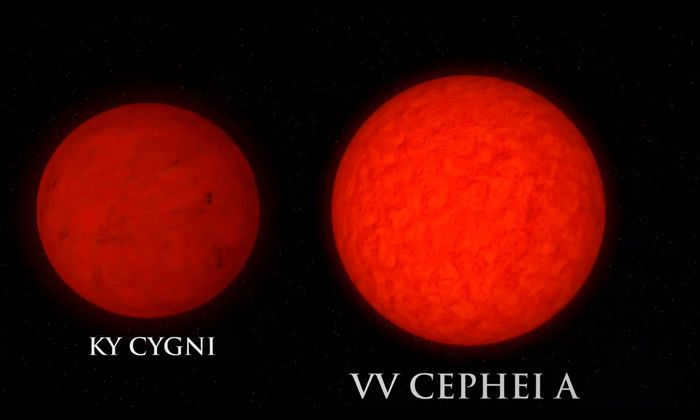
This celestial object is situated in the vicinity of the Cepheus constellation, approximately 5,000 light-years away from our planet. The crimson hypergiant, boasting a radius that is roughly equivalent to 1050-1900 times that of the Sun, forms a binary star system. Accompanying it is a diminutive blue star called VV Cepheus B, which revolves around its “elder sibling” in an elliptical trajectory. The star has been designated with the name of the more massive member and has gained recognition as one of the most substantial binary stars within the Milky Way galaxy.
8. AH Scorpius
AH Scorpius is the eighth constellation in the zodiac.
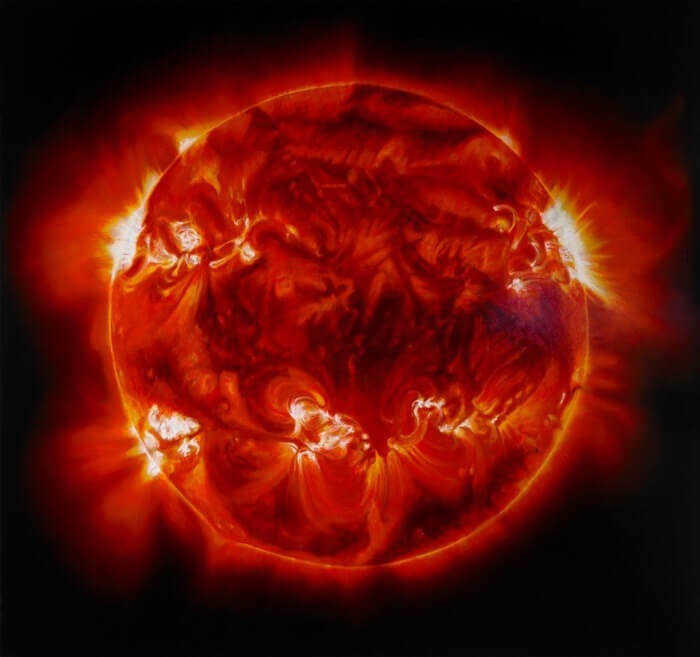
In order to observe this red supergiant star located in the Scorpius constellation up close, one would need to journey a staggering 7,400 light-years. AH, the red supergiant in Scorpius, boasts a radius that is a whopping 1,411 times larger than that of the Sun.
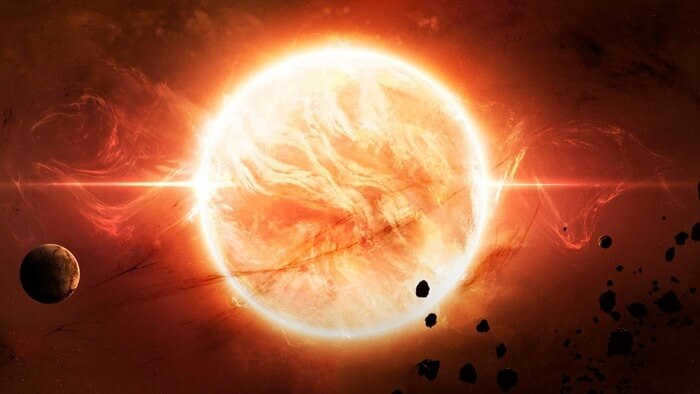
There is a lot of controversy surrounding this particular star in the astronomical community. Based on calculations made in 2012, its radius is estimated to be 1420 times larger than that of the Sun. However, the original estimate by Robert Humphreys suggests that the radius of VY Big Dog is actually between 1800 and 2200 times the radius of the Sun. The exact size of this giant star has yet to be determined. Once it is accurately measured, it may potentially change the current ranking of the largest stars in the universe.
6. KY Swan
KY Swan is a well-known name in the field of music. He has gained a lot of popularity for his unique style and mesmerizing performances. KY Swan is not just a singer but also a songwriter and producer. His music is a blend of various genres, including pop, rock, and R&B.
KY Swan’s talent was recognized at a young age, and he started his musical journey by performing at local events and shows. His dedication and passion for music helped him gain a loyal fan base, and he soon became a rising star in the industry.
One of the things that sets KY Swan apart from other artists is his ability to connect with his audience on a deep level. He writes songs that resonate with people’s emotions and experiences, and his performances are filled with raw energy and emotion.
In addition to his musical talent, KY Swan is also known for his philanthropic work. He has been involved in various charitable organizations and has used his platform to raise awareness for important causes.
Overall, KY Swan is a multi-talented artist who continues to impress his fans with his unique style and heartfelt music. He is definitely someone to watch out for in the music industry.
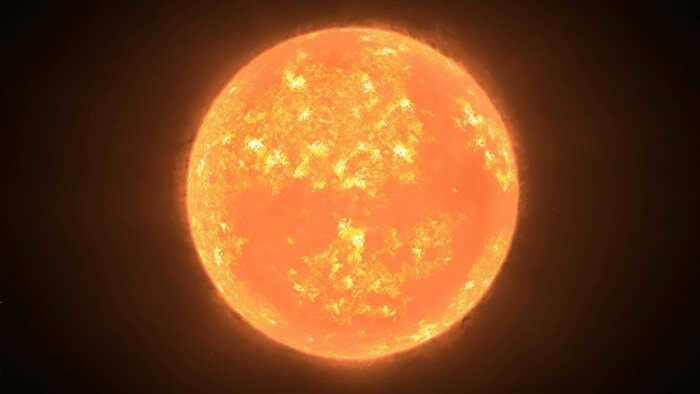
This colossal star possesses a size no less than 1,420 times that of the Sun, and an intensity level up to 300,000 times greater than that of the Sun. It can be found in the Swan constellation, approximately 5,000 light-years distant from our planet.
5. VX Sagittarius
VX Sagittarius is the fifth star in the Sagittarius constellation.
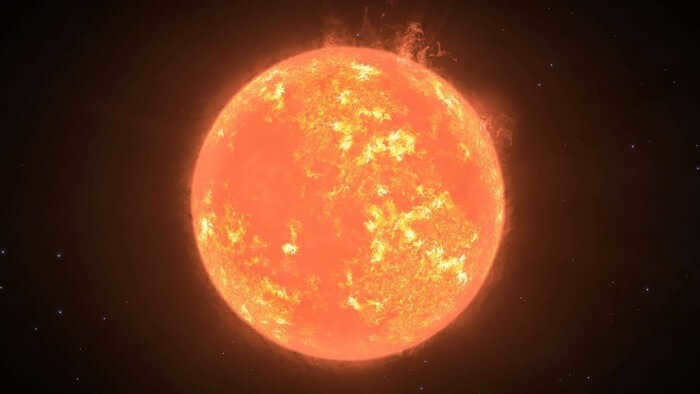
This celestial body is a member of the hypergiant category, which is known for being the most powerful, brightest, heaviest, and also the rarest and shortest-lived group of supergiants. With a radius approximately 1520 times that of our Sun, it is truly immense.
VX Sagittarius is situated in the constellation Cepheus, a staggering 9,000 light-years away from Earth. Its enormous size is exemplified by the fact that it could easily engulf the entire orbit of Saturn if it were positioned in place of our Sun. The star’s red hue is indicative of its temperature range, which falls between 3,000 and 4,000 Kelvin on the temperature scale. In contrast, stars that are hotter appear yellow in color, while those that are extremely hot take on a bluish tint.
4. Westerland 1-26
Rephrase the text to make it unique, using the English language and preserving the HTML markup:
4. Westerland 1-26
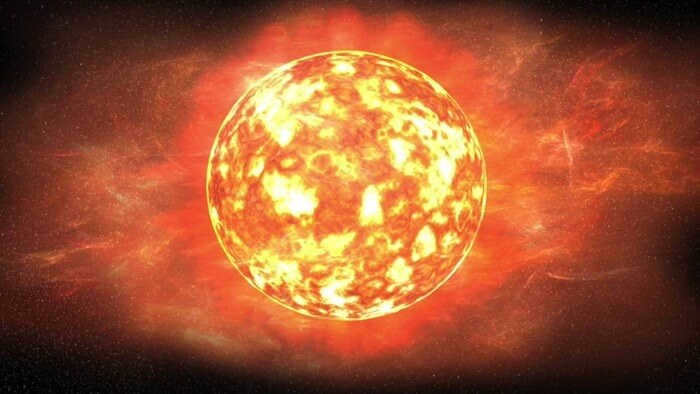
Located in the star cluster Westerland 1, which is approximately 11,500 light-years away from Earth, is a star that holds the rank of the fourth largest in the entire galaxy. This star outshines the Sun by an astonishing 380 thousand times in terms of its luminosity. If it were to replace our yellow luminary, its photosphere would engulf even the largest planet in our solar system, Jupiter. The photosphere is the layer of a star where light becomes transparent and photons, or light particles, can vanish. It is through the photosphere that astronomers can gain insight into the outer boundaries of a star.
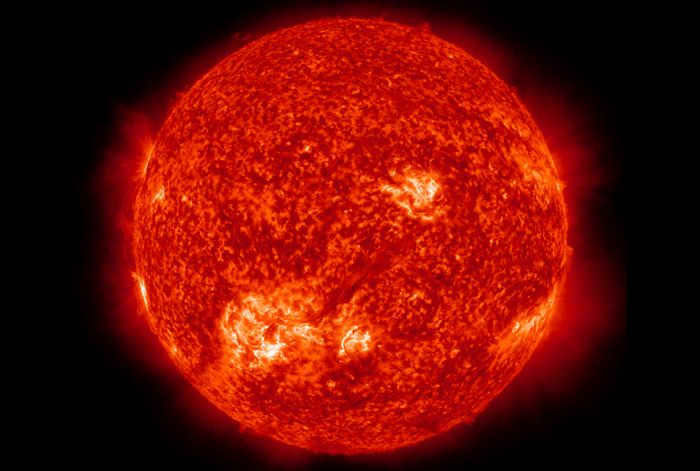
Another star from the constellation Cepheus has been identified by scientists as one of the largest stars. This particular red supergiant has a radius that is approximately 1600 times that of the Sun. To put it into perspective, if RW Cepheus were placed in the position of the Sun, its photosphere, the outer layer of its atmosphere, would extend beyond the orbit of Jupiter.
2. WOH G64
Let’s rephrase the text, making it unique, using the English language while preserving the HTML markup:
2. WOH G64
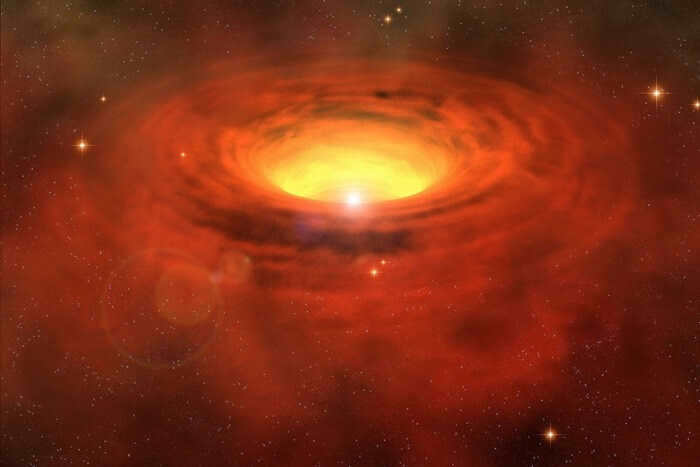
The Goldfish constellation is home to the second largest star in the universe, which is located 160,000 light-years away from Earth. Despite losing a significant portion of its original mass due to stellar winds, the star has managed to form a dense ring of gas and dust around it. The mass of this ring has been taken into consideration when determining the size of the star. Scientists predict that this star will go supernova in a few thousand years.
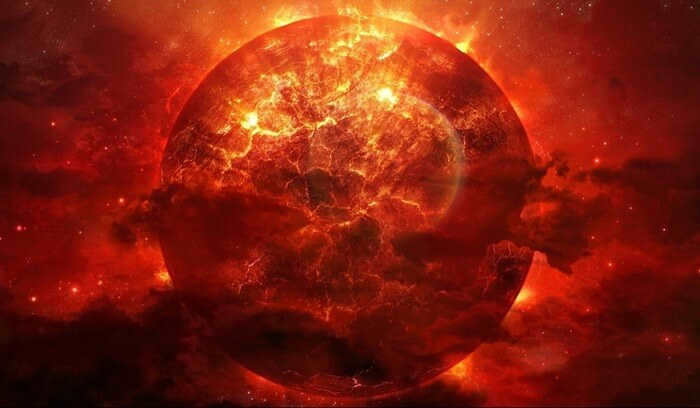
Located in the constellation of Shields, approximately 9,500 light-years away from the Sun, lies the most massive star in existence. With a size equivalent to nearly eight astronomical units, UY Shield’s photosphere extends beyond the orbit of Jupiter, which is the distance between Earth and our Sun.
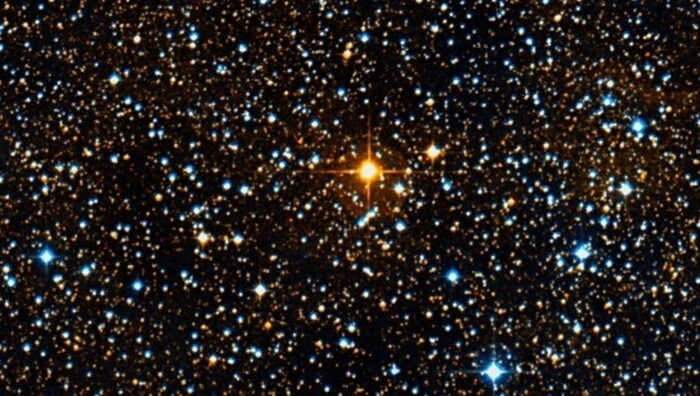
The UY Shield is of such immense size and radiance that it can be observed even with high-powered binoculars during a moonless night. It is discernible amidst the vast expanse of the Milky Way, presenting itself as a crimson-hued star accompanied by a subtle luminescence.
Exploring the enormous star
In the summer of 2012, scientists utilized the Very Large Telescope complex situated in the Atacama Desert in Chile to analyze the characteristics of three colossal red supergiants in the vicinity of the Galactic Center region. The red supergiants under investigation were UY of Shields, AH of Scorpius, and KW of Sagittarius.
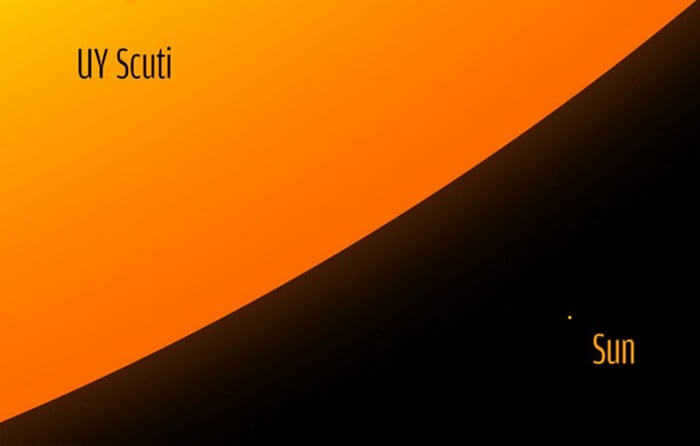
A team of researchers has found that the Sun is dwarfed by three massive stars, each of which is 1,000 times larger and more than 100,000 times brighter than our own star. Furthermore, the scientists have determined that UY of Shields stands out as the largest and brightest among the three stars. By analyzing the stars’ radius and luminosity, they were able to calculate an effective temperature of 3665 ± 134 K for UY of Shields.
The mass of this star is not known exactly, mainly because there is no visible companion star that can be used to measure its mass through gravitational interference analysis. Based on stellar evolutionary models, the initial mass of a star (during formation) that would correspond to a red supergiant stage like that of UY Shield is estimated to be around 25 M☉ (possibly up to 40 M☉ for a non-rotating star) and has been steadily decreasing. It is presumed that its current mass is between 7-10 M☉ and continues to decrease. UY Shields is not only the largest, but also the fastest burning star currently recognized in the field of science.

UY Shield’s mass exceeds that of our Sun by a factor of more than 30, but it’s not even close to being the most massive star. That distinction goes to R136a1, which has a mass 265 times that of the Sun, yet a radius only 30 times larger.
In the realm of celestial bodies, mass and physical size don’t always align, especially when it comes to giant stars. So while UY Shield may only be 30 times more massive than the Sun, its radius is estimated to be around 1700 times the size of our daytime star. The margin of error for this measurement is approximately 192 solar radii.
Is it possible for life to exist near UY Scuti?
The concept of a habitable zone, or the region in which life could potentially exist, is a complex one and depends on several factors. One of the key considerations is the distance between the planet and its star. It is estimated that the habitable zone around UY Scuti would extend from 700 to 1,300 astronomical units (AU). To put this into perspective, this distance is incredibly vast – approximately 149,597,870,700 kilometers. In comparison, the habitable zone in our own solar system extends from 0.95 to 1.37 AU from the Sun.
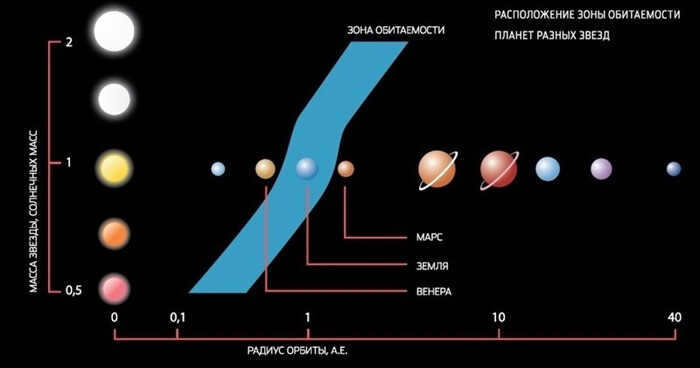
Assuming a living planet is located at a secure distance, let’s say 923 astronomical units away from the UY Shield, the duration of a year on this planet would be equivalent to 9612 Earth years. This means an incredibly long period of 2500 years of winter, followed by another 2500 years of summer. Consequently, generations will come and go without experiencing the diversity of seasons.
While it’s possible for the UY Shield to have a planetary system within this habitable zone, it is unlikely to sustain for a significant period of time. You might wonder, “Why?” The answer lies in the star’s unprecedented brightness and its future trajectory.
According to current models of stellar evolution, scientists propose that UY Shield initiated the fusion of helium in a shell around its core. As the helium is depleted, the star will progress to fusing heavier elements like lithium, carbon, oxygen, neon, and silicon. The star’s location deep within the Milky Way indicates that it is abundant in metals. Once the fusion of heavy elements takes place, the star’s core will begin producing iron, disrupting the equilibrium between gravity and radiation, ultimately resulting in a supernova. This event is projected to occur in a million years – a relatively short period of time in astronomical terms, but humanity will have ample time to prepare for this awe-inspiring spectacle.
Following the supernova, UY Shield will likely transform into a yellow hypergiant, a blue variable star, or even a Wolf-Rayet star characterized by extremely high temperature and luminosity. In the latter scenario, it will act as a “nursery” for the birth of numerous new stars subsequent to its supernova.





